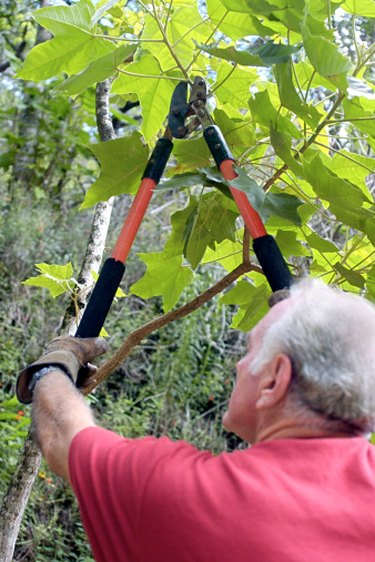Things You'll Need
Loppers
Fine-toothed pruning saw
Ladder

Chinese pistache (Pistacia chinensis) is a medium-size, deciduous ornamental tree hardy in all parts of Texas and considered an ideal shade tree for the state by Texas A&M University. The tree grows to 40 feet or more in height and 30 feet in spread, holding deep green leaves until fall when they turn to rich hues of plum and orange. Females trees produce clusters of berries that are an attractant to birds but not suitable for human consumption. Pruning requirements for mature trees are few as the canopy has a naturally attractive form, but young trees should be pruned to develop a strong branch architecture.
Step 1
Prune your Chinese pistache in early spring after the last hard frost has passed but before new green growth is evident. This timing will preserve fall color, berries for wildlife forage and prevent the tree from suffering pruning and drought stress during the heat of Texas summers.
Video of the Day
Step 2
Prune young trees under 4 years of age to ensure a strong branch architecture, which will protect limbs from breakage as the tree ages. Remove limbs with a weak or narrow attachment crotch against the main trunk. Ensure that major scaffold limbs that emanate from the trunk are spaced well apart and alternate along the trunk. Cut away any water sprouts or shoots that fall below your lowest chosen scaffold branches.
Step 3
Groom the tree for health by cutting out any dead, cracked, abrading, broken or diseased branches and limbs down to a point of healthy wood. Sever these at the junction with the parent branch or down to 1/4 inch above a branch spur or leaf node. Discard and never compost cuttings suspected of harboring disease or insect infestation.
Step 4
Thin the branches of the tree to improve the appearance and allow for greater air circulation and sunlight penetration into the canopy. Remove no more than one-third of the canopy volume, focusing cuts on smaller branches and twigs. Distribute the thinning cuts evenly throughout the top and interior of the canopy to ensure preservation of the natural tree form.
Tip
Use loppers to sever twigs and branches 1 inch in diameter or less and a fine-toothed pruning saw to sever anything larger. This will ensure clean cuts without crushing or tearing of the surrouding cambium.
Video of the Day